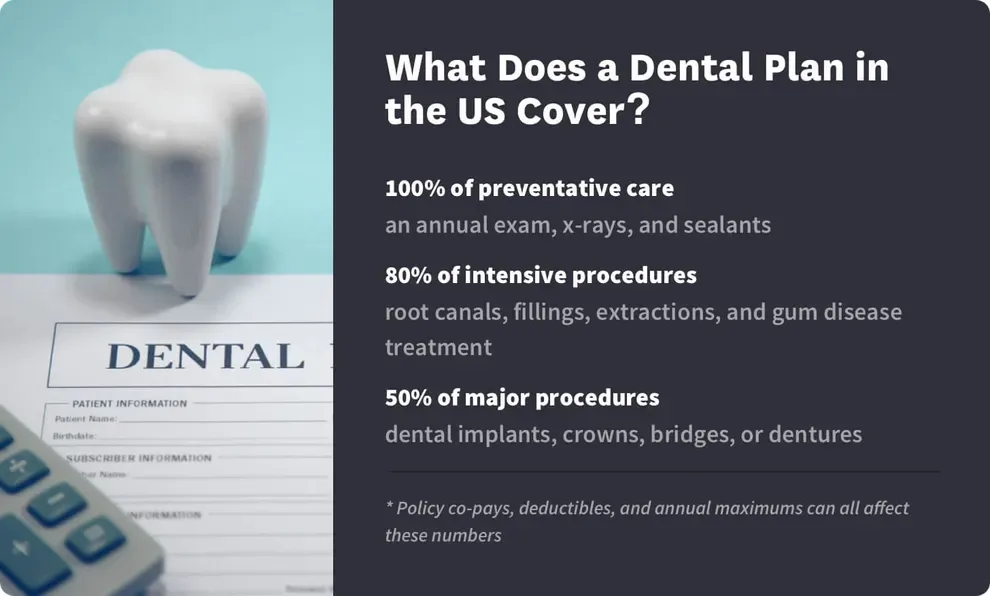US Dental Health Statistics: Tooth Decay, Loss & Cancers

Table of Contents
- US Dental Care & Insurance
- US Dental Insurance
- Mild Dental Problems
- Moderate Dental Problems
- Severe Dental Problems
- US Oral Cancer Rates
- Preventative Oral Health Treatment
- FAQs
- References
Dental care in the United States is very advanced. However, with concern about the cost of care, the cost of dental insurance, and finding a good provider, many people put off symptoms like pain, dry mouth, bleeding, or changes in the appearance of their teeth, leading to moderate or severe oral health problems.
Tooth decay, tooth loss, and some cancers can be prevented and minimized with regular dental visits and a solid oral care routine.

Dental Care & Dental Insurance in the US: Many Put Off Treatment
Although the quality of dental care in the United States is among the best in the world, the cost is also high, even with support from dental insurance. Too many adults put off dental care because they cannot afford it, or they are afraid they cannot afford it.
The Centers for Disease Control and Prevention (CDC) found that over 40 percent of adults felt pain in their mouth at some time over the past year, and more than 80 percent of people will have a cavity before they are 34 years old. Few report these issues to their dentist for treatment. This can consequently lead to worse oral health that requires more intensive and expensive treatment.
There are several services that offer low-cost dental care. Options include dental schools who need volunteers for students, Medicare and Medicaid services, and walk-in clinics that charge an annual “membership” and then charge less per procedure.
Dental Insurance in the United States
Dental insurance in the United States covers part of the cost of essential services like cleanings, fillings, some orthodontics, and oral surgery. Although dental insurance requires a separate payment from medical insurance, it is typically simpler to navigate than standard health insurance.
Your dental insurance company provides a contract through your employer or separately to you as an individual. You can use their resources to find a dental care provider who is in your network.
You may also find a dentist you like and ask if they take your dental insurance. Many dentists now offer this information on their website, so you can find out before you even schedule an appointment.
What is Typically Covered?
Typically, a dental plan will cover:
100 percent of preventative care like an annual exam, x-rays, and sealants.
80 percent for more intensive procedures like root canals, fillings, extractions, and gum disease treatments, depending on co-pay policies and your deductible.
50 percent of major procedures like dental implants, crowns, bridges, or dentures, but you will also pay more out of pocket for these more expensive procedures.
Annual maximums typically range from $1,000 to $2,000 per year, although some plans may reward you for staying with them for multiple years by covering more of your costs and raising your annual maximum.
You will pay a monthly premium for your insurance and likely a co-pay of some type for part of the cost of exams or cleanings. Your insurance may only cover a certain number of visits and cleanings per year, so if you have an ongoing oral health issue, you may pay for some treatment out of pocket, using a payment plan, or using a dental loan. If you are interested in cosmetic procedures, these are rarely covered by dental insurance, although your dentist may help you find a good dental loan program.
Mild Issues That Go Unreported
Because of the cost of dental care, many people who experience occasional or rare common dental problems will not report these to a dentist or schedule an annual visit for a cleaning and exam. Commonly reported mild dental health issues include the following:
Dry mouth
Trouble biting or chewing
Pain
Embarrassment or anxiety over smiling or the appearance of the teeth
Trouble sleeping due to grinding or clenching teeth
Oral health problems like misaligned teeth can contribute to feelings of shame about your smile, but they can also contribute to an increased risk of tartar, infection, and gum disease.
Mild Dental Problems: Plaque Leads to Tartar Buildup
The CDC found that more than 43 percent of adults in the US have some form of periodontal disease, which is typically gingivitis, a moderate infection of the gums that can cause swelling or inflammation, pain or sensitivity, and bleeding. Prior to gingivitis, you are likely to develop plaque and tartar, or calculus. These are normal types of buildup on the teeth from simply eating and drinking, and everyone develops them.
Some people may be more prone to developing plaque or tartar than others due to diet, underlying health conditions, or genetics. Fortunately, a strong oral hygiene routine can manage this daily buildup and reduce your risk of periodontal disease.
Plaque is a thin film that collects on your teeth. This comes from bacteria that naturally occur in your mouth, which secrete acid as they process some chemicals in the food you eat, particularly sugars and starches.
Over time, plaque will harden into tartar, or calculus. This will appear like discolored patches on your teeth. If it is not removed, tartar can spread below the gum line and make teeth harder to clean. Tartar can also make periodontal disease worse.
Brushing and flossing your teeth at least twice per day and visiting your dentist for a cleaning at least once per year are the best ways to prevent periodontal disease. Your dentist will remove plaque and tartar during your annual cleaning. If it has been a while since you last saw a dentist, you may need a deep cleaning to remove persistent tartar and pockets of disease.
In 2016, there were about 45,000 cases of oral and pharyngeal (throat) cancer diagnosed in the US, and there were about 10,000 deaths associated with these types of cancer.
Moderate Dental Problems: Tooth Decay & Gum Disease
There are two common forms of dental health problems that can be easily fixed by your dentist, especially if you get one or two exams per year: cavities and gum disease.
Known to dentists as dental caries, cavities are considered preventable, but they are one of the most common oral health problems in the United States. A cavity is a hole or wearing of enamel on a tooth caused by bacterial infection and associated buildup of plaque and tartar on the teeth.
Consuming foods and drinks high in carbohydrates, especially processed sugar or alcohol, can increase the amount of acid secreted by bacteria in the mouth, which can wear away enamel faster, lead to larger pockets of disease, and demineralize the roots of your teeth. About a quarter of children, half of adolescents, and 90 percent of adults in the US experience tooth decay leading to cavities.
About 13 percent of children between 5 and 19 years old, and almost 26 percent of adults from 25 to 44 years old, have untreated cavities.
About 4 in 10 adults in the US had gum diseases between 2009 and 2014.
Gingivitis is the most common type of gum disease, causing pain, sensitivity, inflammation, reddening of the gums, and bleeding. This infection can spread into the roots of your teeth and into the jawbone if left untreated. Advanced gingivitis might lead to loosening of the teeth, which could eventually shift teeth out of alignment, raising the risk of developing more plaque and tartar.
As many as one in four adults in the US have untreated tooth decay; 46 percent of adults 30 and older show signs of gum disease. About 9 percent of adults have severe gum disease, which can prompt multiple dental treatments to eliminate infection, root canals, and even tooth extractions.
Severe Dental Health Problems: Tooth Loss & Underlying Conditions
Untreated tooth decay and gingivitis can lead to persistent pockets of infection, including abscesses under the gums, which can spread bacterial infection to other parts of the body. You are also more likely to lose teeth because of advanced tooth decay and gum disease.
While many medical advances, from fluoridated water to improved ceramics, have made dental health easier to achieve, a significant number of adults still struggle with advanced illness that leads to oral surgery. The American Academy of Implant Dentistry found that 3 million adults in the US had dental implants, and about 500,000 get an implant each year. In 2020, about 40.99 million adults had either partial or full dentures due to several missing teeth.
Risk Factors for Serious Oral Health Problems
Some underlying conditions can increase the risk of serious oral health problems, including these:
Arthritis
Heart disease or stroke
Diabetes
Emphysema
Hepatitis C
HIV
Obesity
There are also some medications used to treat chronic health conditions, like steroids, which can increase the risk of some oral health concerns, like bone loss and tooth loosening.
Oral Cancer Rates in the United States
There are several potential causes of oral and throat cancer, including these:
Smoking or chewing tobacco
Excessive alcohol consumption
Genetics and heredity
Human papilloma virus (HPV) infection in the mouth
One of the major benefits of regular dental exams and treatment is that a dentist gets to know your oral and overall health history. They may be able to spot early signs of mouth and throat cancer before you experience any symptoms.
They can also offer advice and health resources to help you quit smoking, or help you get other types of screening if you have a family history of oral cancer. The five-year survival rate for oral and pharyngeal cancers is 61 percent.
Preventative Oral Health Treatment Is the Best Medicine
About 65 percent of adults went to the dentist in the past year. However, this figure does not mean that those individuals see a dentist annually. Many people may seek dental help only when there is an emergency.
Data gathered by the American Dental Association (ADA) from 2015 found that 21 percent of surveyed adults said their oral health was fair, and 9 percent reported poor oral health. Many reported that they were worried about their smiles, attempted to hide smiling, and feared their smile impacted them during job interviews.
The ADA also found that 77 percent of adults said they had a plan to visit the dentist in the next year, and 95 percent agreed that regular dental visits kept them healthier overall. However, only 37 percent of adults visited the dentist within a year of completing the survey, suggesting there are significant barriers, including money, fear, and time that get in the way of oral health.
Fortunately, improving technology and medical support have allowed some preventative dental treatments to become more affordable and accessible. Teledentistry and at-home, over-the-counter services like clear teeth aligners make oral health more accessible to many people. While they do not replace regular in-person dental care, they can support better oral health and help you get treatment you need.
U.S. Dental Health Statistics FAQs
More than 90 percent of American adults have cavities in their permanent teeth. More than 25 percent of American adults have untreated dental decay. And adults have an average of three or more missing or permanent teeth.
About half of all American adults show signs of gum disease. Regular brushing, flossing, and rinsing can keep plaque from inflaming and infecting your gums. It looks like about half of us aren't using these critical tools.
Per the CDC, in 2019, 66 percent of American adults (ages 18 to 64) went to the dentist in the prior 12 months.
About 90 percent of adults in the U.S. have had a cavity. Over half of adolescents (ages 12 to 19) have had at least one cavity in a permanent tooth.
